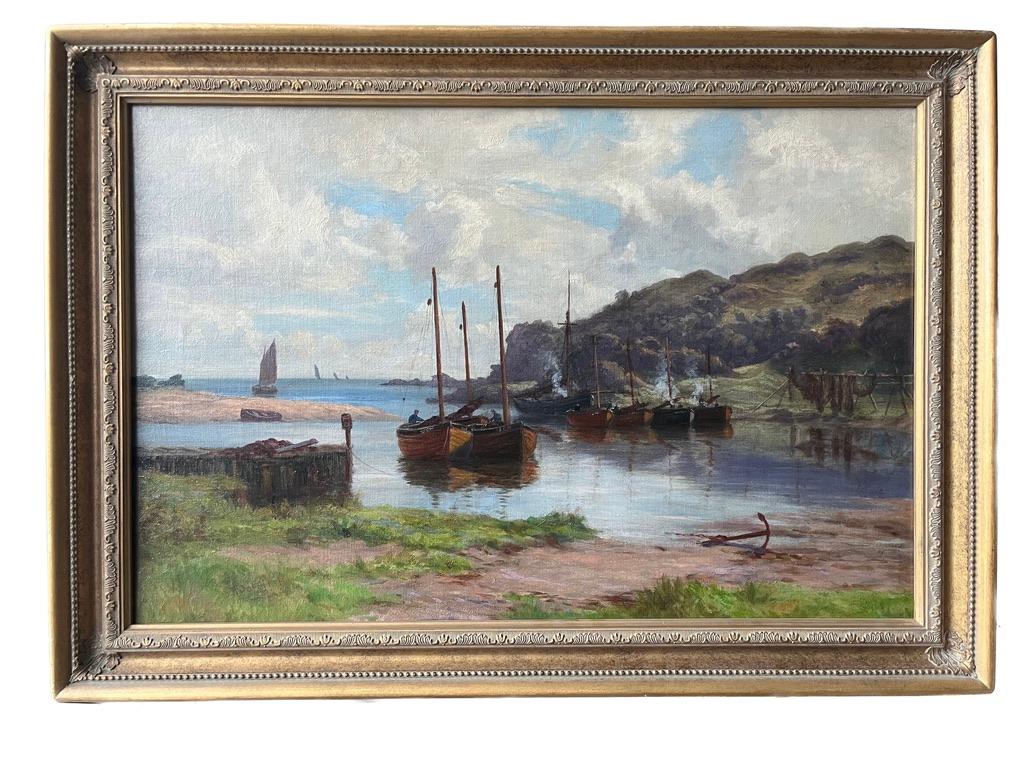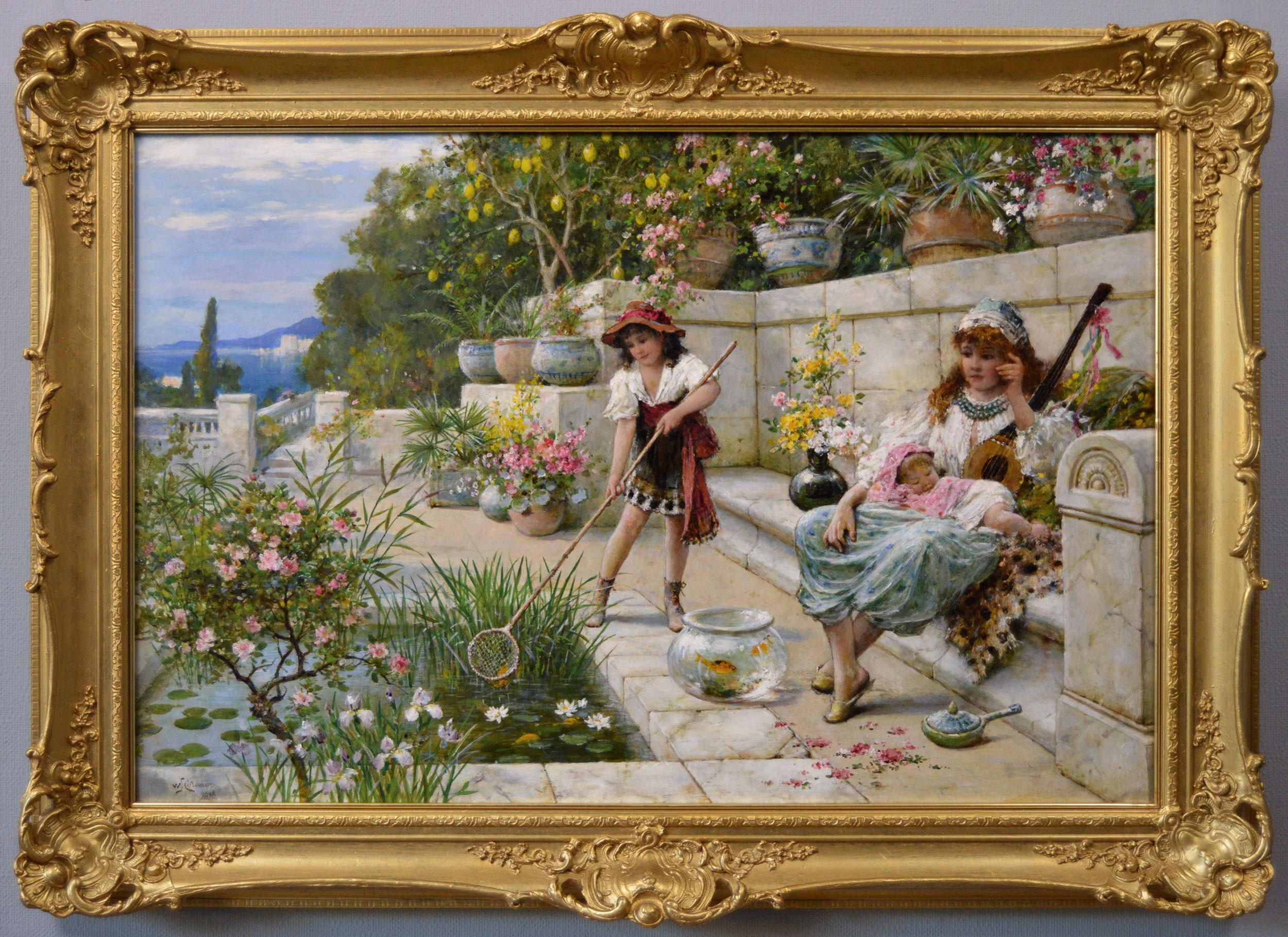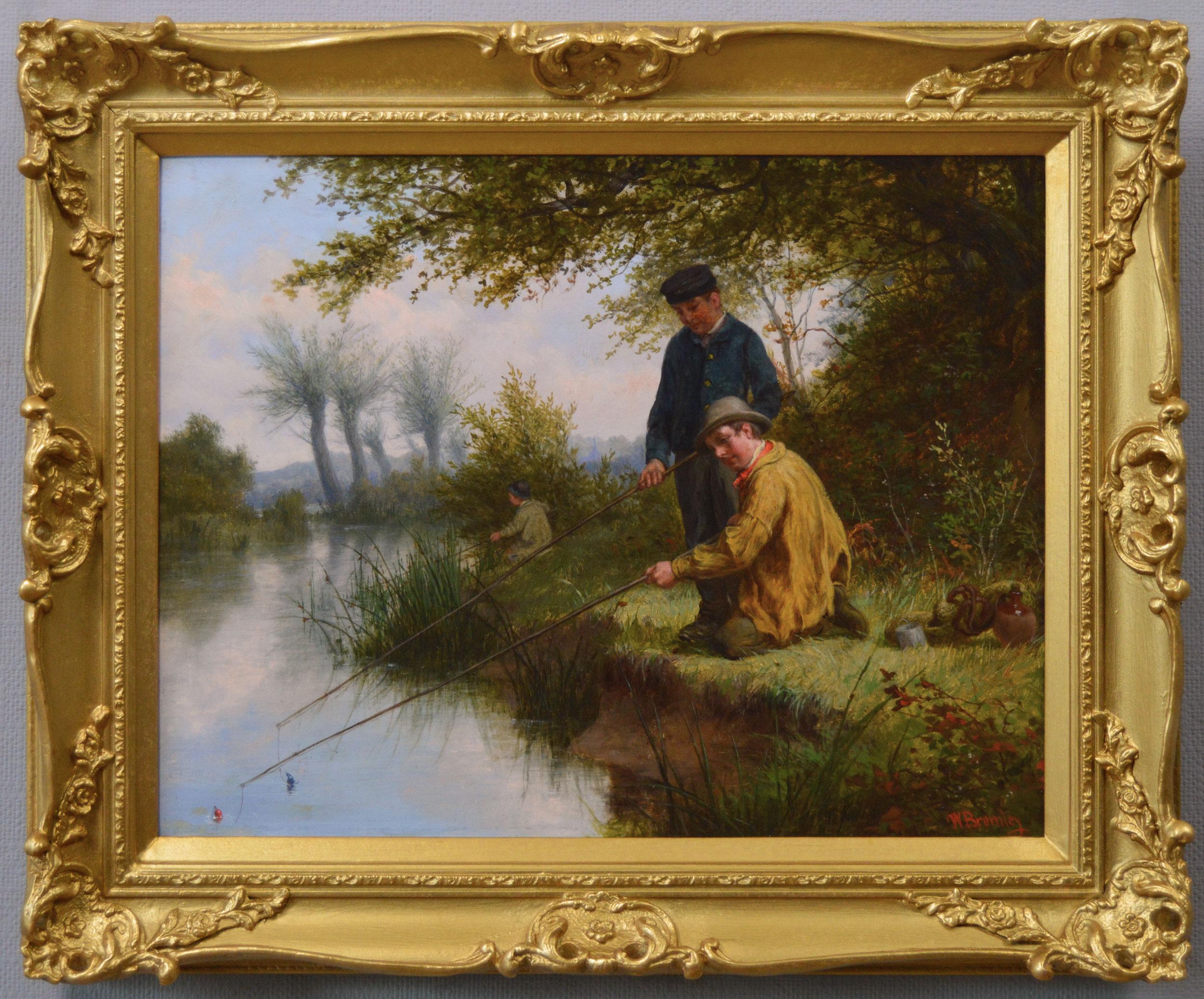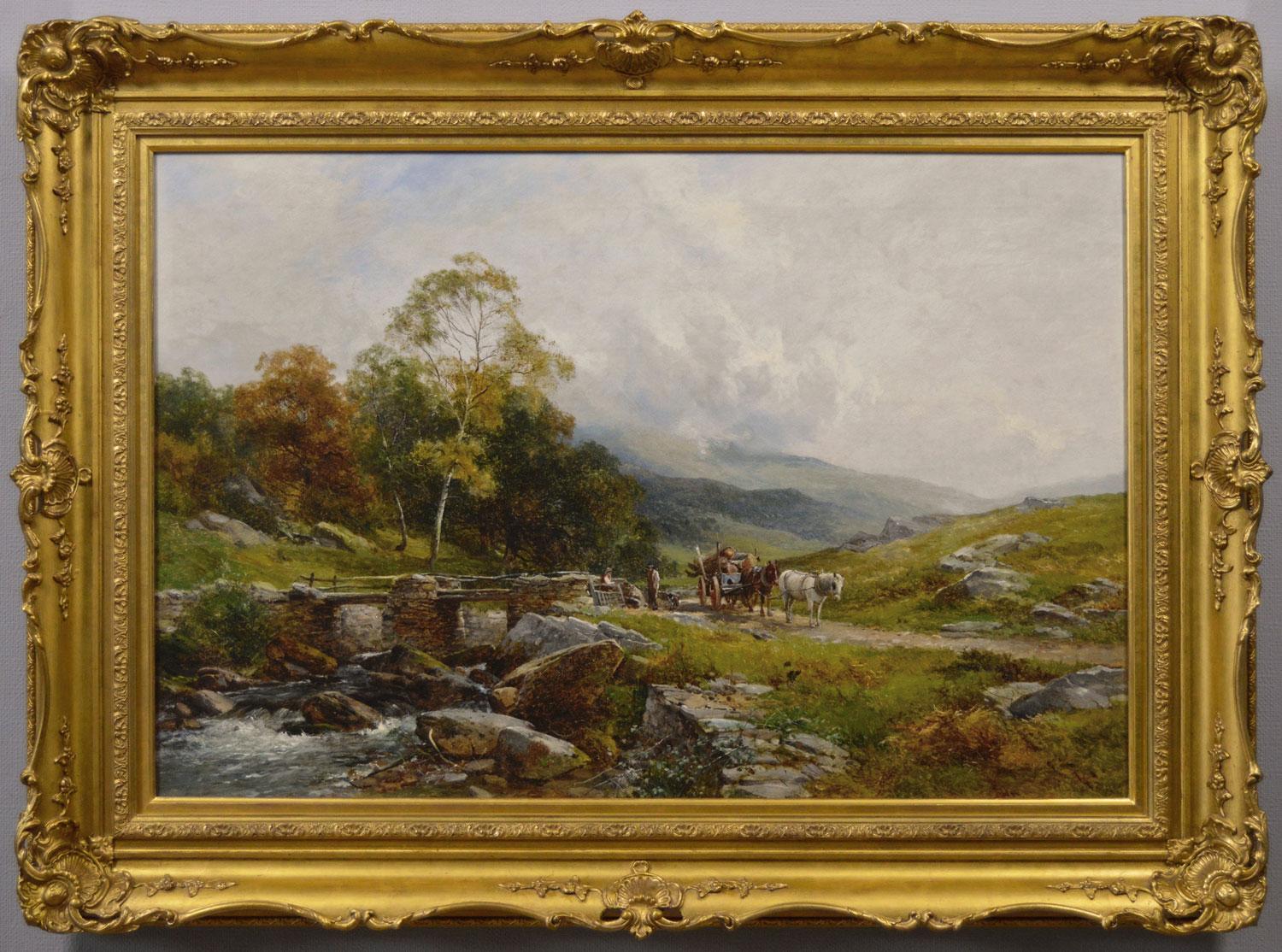Items Similar to David with the Head of Goliath, 19th Century Victorian Oil
Want more images or videos?
Request additional images or videos from the seller
1 of 6
John Rogers HerbertDavid with the Head of Goliath, 19th Century Victorian Oil1850
1850
About the Item
John Rogers Herbert RA
1810- 1890
Oil on canvas, dated '1850' lower right on sword strap
Image size: 33 ½ x 23 ½ inches
Gilt Watts frame
This striking painting, depicts David as a young boy holding behind his back the head of the champion of the Philistines, the giant Goliath, by the hair. The light catches on David's chest, arm and face, on the massive sword hilt of Goliath and the young tree behind, but everything else is quite dark. The two trees obviously represent David and Goliath, with the old larger tree dead and the green younger tree full of light and vigorous youth.
We see a very young courtier, a flamboyant youth of dazzling beauty and with a touch of arrogant defiance on his face. David is shown with his shepherds bag and stick, but also he holds a magnificently decorated but very heavy sword, given to him by King David. This sword evokes in the viewer the impression that the boy might have a great calling. David would indeed become the great warrior and king, the founder of the royal glory of Israel.
For a work painted in 1850 it has quite a surreal and modern feel to it and with its attention to detail you can see why he influenced the Pre Raphaelites.
The Artist:
John Rogers Herbert was born 23 January 1810 at Maldon in Essex. The family had enough money to send young Herbert to London when he was sixteen years old; and he was enrolled in the Royal Academy schools in December 1826. After the death of his father in 1828, Herbert was forced to give up the Academy school and began painting professionally – mostly book illustrations and portraiture. However, sketches from as early as 1829, such as Captives predict his later interest in larger historical subjects with challenging moral themes and complex compositions.
His first exhibit at the Royal Academy was in 1830, Portrait of a Country Boy.
Later in the decade, Herbert, like many of his contemporaries, displayed a growing interest in medievalism. One reason for this may be his friendship with A.W.N.Pugin who would become the co-architect of the Palace of Westminster and a proponent of medieval revival. Herbert and Pugin had known each other from childhood, and were very close, intimately involved in each other’s affairs.
At the age of 28 Herbert was already a success even painting a portrait of Princess Victoria in 1834. In 1841 Herbert was elected an Associate of the Royal Academy, and became a full member in 1846.
Herbert was a prolific teacher of art. In 1841 he became ‘master of the figure’ in the newly formed Government School of Design, a position probably owed to his artist friend William Dyce who was superintendent there, and with whom he collaborated in the illustration of Nursery Rhymes, Tales and Jingles.
Herbert was earnest and methodical in both his subjects and his technique. Evidence of this earnest practice can be found in the extensive research Herbert undertook for many of his paintings. He travelled to the East many times to paint the landscape, clothing and architecture of the area, in order to add authenticity to his biblical scenes.
Herbert’s innovative techniques, borrowing from mediaeval, German and Nazarene art influenced the young Herbert’s innovative techniques, borrowing from mediaeval, German and Nazarene art influenced the young Pre-Raphaelite Brotherhood. He instructed all the young members of the Brotherhood during their sojourn at the Royal Academy Schools, he gave personal support to James Collinson, and perhaps other members, during the formation of the Brotherhood, and was even a potential proprietor of The Germ. Yet, when W.M. Rossetti declared they wished to ‘out-Herbert Herbert’ he had more aesthetic and theoretical considerations in mind. The Pre-Raphelites drew on Herbert’s historical subjects of the 1840s for inspiration, and his influence can be especially seen in their early pictures.
- Creator:John Rogers Herbert (1810 - 1890, British)
- Creation Year:1850
- Dimensions:Height: 33.5 in (85.09 cm)Width: 23.5 in (59.69 cm)
- More Editions & Sizes:1 of 1Price: $30,568
- Medium:
- Movement & Style:
- Period:
- Condition:
- Gallery Location:London, GB
- Reference Number:1stDibs: LU5247319882
About the Seller
5.0
Vetted Seller
These experienced sellers undergo a comprehensive evaluation by our team of in-house experts.
Established in 2007
1stDibs seller since 2014
63 sales on 1stDibs
Typical response time: 2 hours
- ShippingRetrieving quote...Ships From: London, United Kingdom
- Return PolicyA return for this item may be initiated within 14 days of delivery.
More From This SellerView All
- Ophelia, Victorian 19th Century Royal Academy Oil PaintingLocated in London, GBOil on canvas, signed lower right Image size: 33 1/2 x 56 1/2 inches (85 x 143 cm) Original gilt frame Provenance With the artist's son, Millie Dow Stott Esq., until 1912. Artist's Studio Sale, Christies, November 1913. Private Collection Exhibitions London, Royal Academy, 1895, no. 679. Paris, Societe de la Nationale des Beaux-Arts, 1896, no. 1179. Berlin, VII Internationale Kunstausstellung 1897. no. 3533. Manchester, City of Manchester Art Gallery, 1912, no. 339. In the 1890s William Stott exhibited regularly at the Royal Academy, mainly highly decorative works with subjects derived from classical mythology and literature. This painting was Stott's 1895 entry to the Royal Academy and was subsequently exhibited at the Paris Salon of 1896 and then on to the Berlin, VII Internationale Kunstausstellung 1897. Shakespeare was a favourite source for Victorian painters, and the tragic romance of Ophelia, from Hamlet, was an especially popular subject, featuring regularly in the Royal Academy exhibitions. The most popular and iconic image of Ophelia's death was, and is to this day, John Everett Millais's 1851 painting showing the confused and tragic Ophelia floating downstream on her back in a state of mad ecstasy, arms raised in a gesture of inevitable submission. However, although Stott chose not to pastiche this image, it seems highly likely that he was prompted to take up this subject, which had almost become a 'rite of passage' among Victorian painters, by the fact that in 1894 Millais's Ophelia was presented to the National Gallery of British Art by Sir Henry Tate. It appears that Stott was much influenced by John William Waterhouse...Category
Late 19th Century Victorian Figurative Paintings
MaterialsOil, Canvas
- Study for Eastward Ho!, Oil on Panel 19th Century PaintingLocated in London, GBOil on panel Image size: 20 x 16 inches (51 x 40.5 cm) Handmade gilt frame Provenance Family estate This preliminary oil sketch for one of O'Neil's most famous works, "Eastward Ho!...Category
19th Century Victorian Figurative Paintings
MaterialsPanel, Oil
- The WoodcutterBy Alfred EastLocated in London, GBAlfred East The Wood Cutter Oil on board Signed lower right and titled on back Image size: 10 1/4 x 15 inches (26 x 37.5 cm) Carved gilt frame This romantic landscape by East, certainly shows the influence that the Barbizon school had on his work. The Barbizon school were drawn together by their passion and desire to elevate landscape painting as a response to the Academic elevation of historical and mythological themes. Here, East truly revels in the beauty of the English landscape but also captures the mood of the time in which there was a growing concern at the rapidity of social change and its impact upon the countryside. East regularly painted the Cotswolds from the early 1890s until the end of his life - it is probable that this scenes depicts that part of the country. He focused principally on the area around Upper Swell, which he referred to as 'Over Swell', hoping to avoid the village becoming a focus for visitors seeking out the views that he portrayed. East adopted a well established three-stage-technique that made great use of the under-painting, a second layer concerned with the correction of values, and a final stage for the addition of details; all painted with lean oil paint. As can be seen in the work, during this process East practically repainted the entire canvas after the first layer and then proceeded to pick out isolated sections that required further reworking and detail. Provenance Pelter Sands Gallery Bristol, 1975 Exhibition of Twentieth Century British Painting. This work was part of Andrew Vicari...Category
Late 19th Century Victorian Landscape Paintings
MaterialsBoard, Oil
- Tempest 19th Century Oil British SchoolLocated in London, GBBritish School 19th Century TempestOil on board Image size: 9 1/2 x 12 1/2 inches (24 x 32 cm)Category
19th Century Victorian Landscape Paintings
MaterialsBoard, Oil
- Knole House, English School 19th Century Country House Landscape OilLocated in London, GBEnglish School 19th Century Knole House Oil on canvas Image size: 22 ½ x 35 ½ inches Gilt frame This is not only a very beautiful work of art but also a v...Category
1850s Victorian Landscape Paintings
MaterialsOil
- The New Teacher, 19th Century Victorian Interior OilLocated in London, GBGeorge Bernard ONeil 1828-1917 Oil on canvas, signed & dated (18)76 lower right Image size: 22 ½ x 17 inches Original frame The painting depicts the arrival of the new teacher, a curious pupil peeps around a door to see her, while her friends look through the open door to the classroom to catch a glimpse. The artist has gone to great lengths with the painting, such as the highly detailed Dutch tiles on the bottom right of the picture or the window above the door in the background. O'Neil often painted works with several doorways leading off and giving a sense of depth to the work. The use of light and shadow is also cleverly depicted across the work, one light source arrives from where the viewer stands filling the room and the new teacher with light, while the other window above the door in the background also gives a warm glow. George Bernard O'Neill was born on 17th July 1828 in Dublin the ninth of fifteen children of Bernard and Sarah O...Category
1870s Victorian Landscape Paintings
MaterialsOil
You May Also Like
- Victorian landscape painting of the River Thames with horses wateringBy Edwin Henry BoddingtonLocated in Harkstead, GBA very atmospheric scene of a horse and cart crossing the river Wey (a tributary of the river Thames) under a beautiful twilight sky. There is wonderful detail and light with the ar...Category
19th Century Victorian Landscape Paintings
MaterialsOil, Canvas
- Victorian landscape painting of Scottish fishing boats moored in a bayLocated in Harkstead, GBA very tranquil scene of fishing boats moored in harbour with a sunlit sea beyond. Painted with a most attractive palette of blues and greens and with a pleasing composition that le...Category
19th Century Victorian Landscape Paintings
MaterialsOil, Canvas
- 19th Century seascape oil painting of Penzance harbour, CornwallBy William Edward WebbLocated in Moreton-In-Marsh, GloucestershireWilliam Edward Webb British, (1862-1903) Penzance Harbour Oil on canvas, signed Image size: 29 inches x 45.5 inches Size including frame: 38 inches x 54.5 inches A pleasing coastal painting of Penzance Harbour at low tide by William Edward Webb. In the foreground, a fisherman sells his catch to a woman and her daughter, whilst figures in horses and carts wait for others to unload their boats. William Edward Webb was born in Cheltenham, Gloucestershire in 1862 to William Benjamin Webb and Ellen Butler. His father was a printer and an artist and it is highly likely he received tuition from him. Following the death of his mother, his father remarried and moved the family to Manchester sometime after 1871. By the 1880’s, Webb had started working as an artist and later set up a studio at 30 Exchange Buildings in Manchester. He began exhibiting at the Manchester City Art Gallery from 1890, where he showed more than 60 paintings during his lifetime. He also exhibited at the Royal Academy and Walker Art Gallery Liverpool from 1892. He married Clara Foster in 1899 and the couple lived at 1 Sylvan Grove, Chorlton Upon Medlock in South Manchester with their daughter Florrie. He became friends with the artist Walter Emsley (1860-1938) who also lived in Manchester. Although he spent the rest of his life in Manchester, Webb travelled throughout the UK painting coastal and marine scenes around the main ports and harbours. He spent a great deal of time in the Isle of Mann painting numerous scenes along the coast including views of Peel and Douglas Harbour, subjects he frequently returned to. Webb painted in a highly distinctive style; loose and informal but which manages to retain the sense of perspective. He struggled with ill health and depression throughout his life which sadly led to his suicide 9 November, 1903. In 1974, a retrospective exhibition was held at The Old Customs House and Old Solent House in Lymington, which brought a new found interest in his work. His paintings are now highly sought after and are represented in many collections and Museums including the Astley Hall...Category
19th Century Victorian Landscape Paintings
MaterialsOil, Canvas
- 19th Century genre oil painting of a woman in a garden with two girlsBy William Stephen ColemanLocated in Moreton-In-Marsh, GloucestershireWilliam Stephen Coleman British, (1829-1904) By the Fish Pond Oil on canvas, signed & dated 1898 Image size: 23 inches x 35 inches Size including frame: 30.25 inches x 42.25 inches A beautiful painting by William Stephen Coleman of a woman with two girls in a semi classical style by a Mediterranean pond. The woman is depicted resting on a terrace with her young daughter asleep on her lap, whilst another child catches goldfish in a bowl. This tour de force would have most likely been painted by Coleman as an exhibition piece. William Stephen Coleman was a figurative painter who was born in Horsham in 1829. He was one of 12 children born to a physician named William Thomas Coleman and his wife Henrietta (née Dendy). Three of his siblings Rebecca Coleman (b1837), Helen Cordelia Angell (1847–1884) and George Coleman also became artists, inheriting their artistic talent from their mother’s side of the family. Coleman developed an interest in nature from an early age, producing drawings as a hobby. Despite his ability, he initially followed in his father’s footsteps and trained as a surgeon. However, this proved unsuccessful and by the age of 21 he had turned back to art, later gaining employment with the Dalziel Brothers, a firm of wood engravers who specialised in natural history illustrations. Sometime during the late 1850’s he moved to London where he married his first wife Henrietta Augusta Boultbee in 1858. Around the same time, he began producing illustrations for books; the first of which was entitled ‘Common Objects of the Country’ and published in 1858. He subsequently published two of his own books ‘Our Woodlands. Heaths, and Hedges’ in 1859 and ‘British Butterflies’ in 1860. After the death of his wife in 1860, his sister Rebecca and brother George went to live with him in Garway Road, Paddington. Rebecca would often assist him with the wood blocks for his illustrations. As well as working as an engraver, he also began producing classically influenced paintings featuring figures in landscapes. Initially these were executed in watercolours but later extended to oil paintings. He began exhibiting at the Dudley Gallery in 1865 and was one of the original committee members. He continued to exhibit there until 1879 and was a committee member up until 1881. By 1869, he had also begun to work on pottery decoration and in 1871 was asked by Minton’s to establish an Art Pottery Studio at Kensington Gore. Whilst at Minton’s, he produced figure designs for their ceramic ware. His sister Rebecca also worked at Minton’s and they moved to Belle Vue in Chelsea to be closer to the studio. From 1881, he lived at 3 St John’s Wood Studios, Queens Terrace in Paddington and in 1888 moved to 43 Broadhurst Gardens in Hampstead. In 1893 one of his classically inspired works ‘The Gold Fish Bowl...Category
19th Century Victorian Figurative Paintings
MaterialsOil, Canvas
- 19th Century genre landscape oil painting of three boys fishing on a riverBy William BromleyLocated in Moreton-In-Marsh, GloucestershireWilliam Bromley British, (1816-1890) Gone Fishing Oil on canvas, signed Image size: 13.5 inches x 17.5 inches Size including frame: 18.75 inches x 22.75 inches A picturesque genr...Category
19th Century Victorian Figurative Paintings
MaterialsOil, Canvas
- 19th Century Welsh landscape oil painting of figures by the River GlaslynBy David Bates b.1840Located in Moreton-In-Marsh, GloucestershireDavid Bates British, (1840-1921) Early Morning on the Glaslyn Oil on canvas, signed & dated 1895, further inscribed verso Image size: 23.25 inches x 35.25 inches Size including fra...Category
19th Century Victorian Landscape Paintings
MaterialsCanvas, Oil
Recently Viewed
View AllMore Ways To Browse
The Head
With The Head Of
Great Art Of The 19th Century
David M
David Head
Black Painted Victorian
Victorian Black Art
Paintings Victorian London
Head Of David
German 19th Century Oil
Oil Victorian Royal
Victorian King
King David
Chest With Painting
Oil W Royal
Very Large 19th Century Oil Painting
Victorian Family Painting
Large Victorian Gilt





